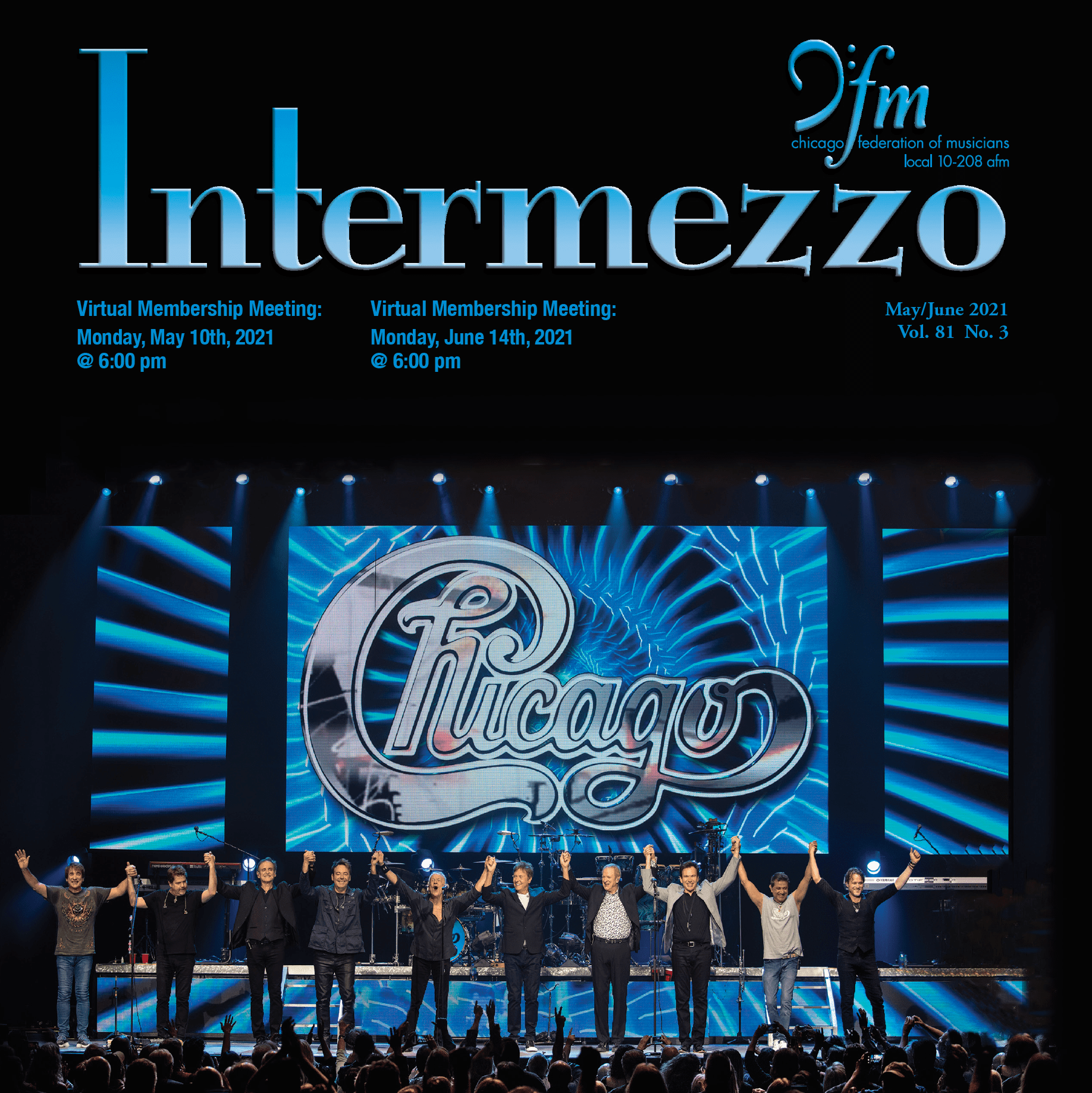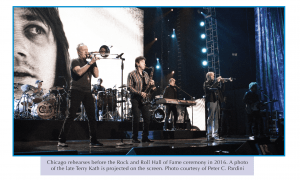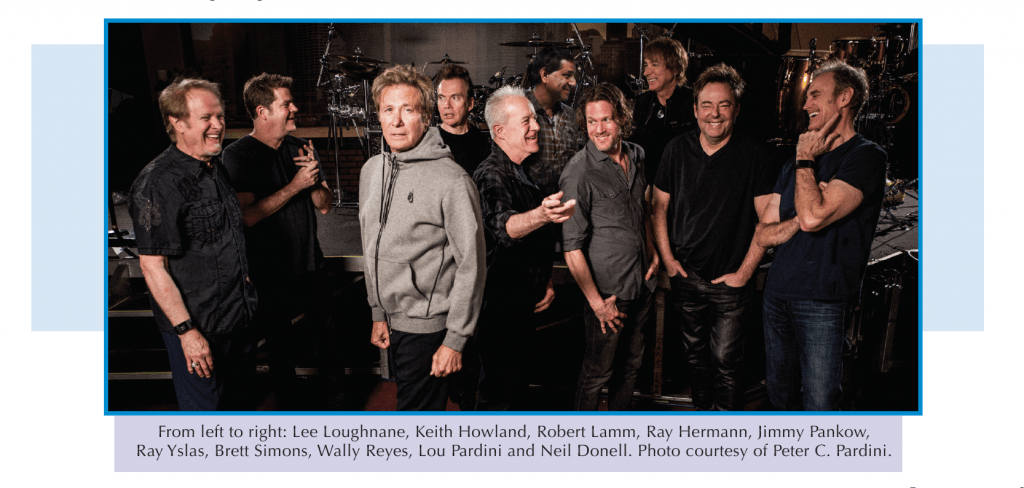Musician Profile: Chicago’s Jimmy Pankow and Lee Loughnane

Chicago’s Jimmy Pankow and Lee Loughnane Discuss the Band’s Beginnings, the Evolution of Their Sound and Life in the Time of COVID with the Chicago Federation of Musicians.
“Man, it’s been a drag,” laments trombonist Jimmy Pankow from his house in Nashville, briefly taking off his black baseball cap to run his fingers through his silver hair. “I haven’t been home this long in 52 years. I don’t know what to do with myself!” Trumpeter Lee Loughnane, ensconced in his Sedona, AZ home, is equally restless. “I’m writing songs for the new album. We’re all sending material to our producer, Joe Thomas. But getting together in the same room to record them is another story.” On March 14, 2020, Chicago – the iconic band with a 50+-year history – left their last gig at the Venetian in Las Vegas. The plan was to head to California the next day for another show in a schedule of 100 tour dates that year, until the coronavirus changed everything. But, when a group has been playing together for this long, challenges are to be expected. Their extraordinary run – with the sales of over 40 million albums; tours with Janis Joplin, Jimi Hendrix and the Beach Boys; and induction into the Rock and Roll Hall of Fame in 2016 – has seen songs that didn’t climb the charts, evolving audience tastes and changes in personnel. The virus is just another bump in the road on what Pankow calls “the journey.” “If we knew what was coming next, what fun would it be?” he says. Still, “Who’d have thought we would have seen this (pandemic) in our lifetime???”
 The band got its start in 1967, when Pankow and Loughnane were students at DePaul University. Pankow, a sophomore at the time, had come up to DePaul after spending a year downstate at Quincy College. For a few weeks, “(reedist) Walt (Parazaider) kept peering at me through the practice room door window. He finally introduced himself and said he wanted to put together a rock and roll band with a horn section that would be a main character in the music, not just an afterthought.” Loughnane, who had won a position with the Civic Orchestra of Chicago and was working the club scene, was already on board.
The band got its start in 1967, when Pankow and Loughnane were students at DePaul University. Pankow, a sophomore at the time, had come up to DePaul after spending a year downstate at Quincy College. For a few weeks, “(reedist) Walt (Parazaider) kept peering at me through the practice room door window. He finally introduced himself and said he wanted to put together a rock and roll band with a horn section that would be a main character in the music, not just an afterthought.” Loughnane, who had won a position with the Civic Orchestra of Chicago and was working the club scene, was already on board.
“I had met (guitarist) Terry Kath and (drummer) Danny (Seraphine) from a local band called the Missing Links. They invited me to come and sit in. When that band broke up, they invited me to join a band we initially called The Music Foundation. Then we changed the name to the Big Thing, then the Chicago Transit Authority, and then Chicago.” Parazaider had invited keyboardist Robert Lamm into the group, and Peter Cetera joined on bass.
The early days were an experiment in trying to find their sound. “For the first six months or so, we were a glorified Vegas band,” explains Pankow. “We wore cheap suits, did steps. At gigs, we were expected to perform top 40, which was R&B at the time: Temptations, the Four Tops, Wilson Pickett. But I continued to work on the original concept away from the clubs. Robert started bringing in his arrangements of these R&B classics, and that led to original songs. We were doing custom horn arrangements that took the song to another place and I began inserting instrumental sections to extend the songs.”
“Jimmy incorporated the brass as though they were a vocal” adds Loughnane. “He made the three horns sound bigger because of the way he voiced the chords.”
Unfortunately, this new approach didn’t immediately lead to success. “No sooner did we start sticking some of this original material in the sets that we started getting fired from one club after another!” exclaims Pankow. “They didn’t want to hear us, they wanted to hear Top 40! We had to make a decision: did we want to do the shtick and play Top 40, or did we want to pursue our own voice?” In 1968, a former DePaul student turned producer named James Guercio convinced the band to move to Los Angeles. “His goal was to try bring talent from Chicago and put them on the map, get them recording deals and launch them nationally,” says Pankow. “Guercio heard us do the Top 40, but on the second or third set, we started playing original arrangements of other songs, and he was visibly impressed. Since we couldn’t rely on most of these clubs to be a platform for our music, we packed up U-Hauls and headed to LA.” Going to California had been the right decision. “We moved to a house under a freeway, and it was in a great community. Every other house was occupied by a band. It was a like a pop renaissance. We felt like we were exactly where we needed to be. It represented the freedom to do our thing, and we rehearsed day and night.”
Success came quickly. Jimi Hendrix had heard them play at the infamous West Hollywood club, the Whisky a Go Go, and invited them to be his opening act on tour. Recalls Pankow: “It was amazing. We were waiting to go on for the next set, and there’s Hendrix standing in the doorway. Hendrix asked if we wanted to go on the road, and we said ‘Yeah!’ It was intimidating! There were 20,000 people in the audience instead of a little club.” Audiences could be harsh. “We’d go out on stage and we’d hear ‘We want Jimi!’ And Walt would go up to the mic and go ‘Shut the *%$^# up and listen!’ We didn’t know any better, we were street guys from Chicago. It was a magical time!”
Guercio signed the band to Columbia Records, and they released their first album, Chicago Transit Authority, in 1969. It hit the Top 20 and went on to sell over 2 million copies. In 1970, their second album (Chicago, or sometimes called Chicago II) yielded timeless hits such as ‘Make Me Smile’, ‘Does Anyone Know What Time It Is’, ‘Colour My World’ and ‘25 or 6 to 4’. Over the next seven years the band recorded seven more albums, embarked on tours at Carnegie Hall, Japan and Tanglewood, and produced songs like ‘Saturday in the Park’, ‘Feelin’ Stronger Every Day’, ‘Just You ‘n’ Me’, and ‘(I’ve Been) Searchin’ So Long’ reach the Top Ten.
The next few years brought tragedy, hardship and change. In 1978, guitarist Terry Kath accidentally shot himself to death while cleaning his gun. The band, griefstricken, chose to continue, but much of their direction had come from Kath, and the next three albums (Hot Streets, Chicago 13, and Chicago XIV) failed to achieve the success of previous records. After Chicago XIV, Columbia Records lost confidence in the group and bought them out of the rest of their contract. Right before Kath’s death, the band had split from Guercio over matters of control and money, so in 1981, Chicago found itself without a producer or a label.
That same year, entertainment executive Irving Azoff signed the band to his label Full Moon/Warner Brothers. “He asked if we would like to work with David Foster, who was a new producer,” says Loughnane. Foster’s method was to pick one voice within an ensemble and mold the album to what that single artist did best. In this case, he focused on Peter Cetera’s voice and towards a balladic style that saw hits like ‘Hard to Say I’m Sorry’, ‘You’re the Inspiration’ and ‘Hard Habit to Break’. “We let David pick the songs and he made the album, but he didn’t allow Jimmy to do any brass arrangements, and he ended up over-producing us.”
It wasn’t just the music that changed. The 80’s brought the MTV era, and new songs weren’t jockeying just for airplay. “Not only did we want to get on radio – we had to get on TV!” recalls Pankow. “We jumped on that ship because everyone became judged on their success on MTV. But it was a kick! We had the first “stunt” video for ‘Stay the Night’, with stunt drivers and a spectacular car crash! We filmed it in South LA along a concrete viaduct. It was out in a neighborhood and there were hundreds of people watching what was going on. Because they had the music blasting on speakers so we could mouth the lyrics, the people were hearing all this music and witnessing these car crashes and next thing you know we had 1,000 spectators! It was awesome!” Pankow smiles. “We won an MTV award for that video.”
Adds Loughnane: “It was fun, although the thing with videos and the MTV era was that the songs took a back seat to the video production. The vision was the video, not the vision that the song would leave to the imagination.”
 In 1985, Cetera left for a solo career, and the band moved away from ballads and steadily made its way back to the horns. Chicago kept up their prolific pace with eleven more albums including four Christmas records, a cover of big band classics and an album called Stone of Sisyphus, which marked a return to their original compositional and ‘horn-centric’ style from the 1970s. Their touring schedule, which rarely lagged, consists of five shows per week for months on end. The band also has gone through a number of personnel changes. Says Pankow: “Our current lineup is AMAZING: Lee, Robert, myself, Neil Donell (lead tenor vocal), Brett Simons (bass and keyboard), Keith Howland (guitar), Lou Pardini (keyboard), Walfredo Reyes (drums), Ray Yslas (percussion) and Ray Hermann (reeds).”
In 1985, Cetera left for a solo career, and the band moved away from ballads and steadily made its way back to the horns. Chicago kept up their prolific pace with eleven more albums including four Christmas records, a cover of big band classics and an album called Stone of Sisyphus, which marked a return to their original compositional and ‘horn-centric’ style from the 1970s. Their touring schedule, which rarely lagged, consists of five shows per week for months on end. The band also has gone through a number of personnel changes. Says Pankow: “Our current lineup is AMAZING: Lee, Robert, myself, Neil Donell (lead tenor vocal), Brett Simons (bass and keyboard), Keith Howland (guitar), Lou Pardini (keyboard), Walfredo Reyes (drums), Ray Yslas (percussion) and Ray Hermann (reeds).”
What do musicians who’ve been on the road for half a century do during quarantine? “I’ve been practicing!” says Loughnane. “I do Claude Gordon routines. I watch YouTube videos of Arturo Sandoval and Wayne Bergeron. Every player learns that playing live is different from practicing, which is much more controlled. That’s when you put your endurance chops back together. I played a benefit show for ‘Cancer Blows’, where 30 trumpet players – first chairs from major symphonies, jazz players from all over the world – got together for an online concert. God, that was amazing. Just watching all those players from the side of the stage, that taught me a lot. I learned how to breathe better. I’ve been working on breathing the whole time, but seeing those guys was different.
“And I put together a studio here in Sedona with an SSL Console, so I pretty much know what I want to do when I grow up,” he jokes. “If (my performing career) ever ends, I have something to do.”
But, the road is where they want to be. Says Pankow, “There’s nothing like live performance. I miss it so much. I miss hanging out on the bus, talking about the show before we go on. We’re talking to Live Nation every day to see when we’ll perform live again. Thank God we have this record project to keep us focused and creatively engaged. It’s a refreshing departure in many ways from what people have been accustomed to, though it has the Chicago ‘thumbprint’. “Being inactive is the toughest thing I’ve ever had to do. You gotta keep in shape. For now, I do the standard calisthenics: long tones, arpeggios, intervals, lip slurs. I practice endurance; I try to push myself a little beyond fatigue. The first three shows of any tour are the hardest because all the practicing in the world doesn’t prepare you for this level of performance. I can practice all day long, but when we go back on the road, get the ice packs ready!”
“There’s three things I live by: 1. practice; 2. be passionate, be in the moment, love it; and 3. HAVE FUN. If it’s not fun, then it’s not worth it. I’m in my 70s now, but I don’t think of myself as being an old guy. My spirit hasn’t changed; I’m still a maniac!”
Reprinted with permission from the May-June 2021 issue of the Intermezzo